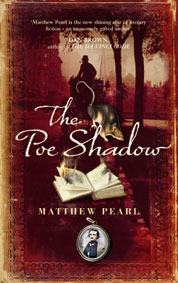
Believe it or not, a recent best-selling novel features C. August Dupin, the Rue Morgue, and the doppelganger motif. It's called The Poe Shadow by Matthew Pearl (author of The Dante Club and The Last Dickens).
You can read an excerpt here, or read the promotional description:
The body of Edgar Allan Poe has been buried in an unmarked grave.  The public, the press, even Poe's own family and friends accept the conclusion that Poe was a second-rate writer who met a disgraceful end as a drunkard. But none of this deters a young Baltimore lawyer named Quentin Clark.
The public, the press, even Poe's own family and friends accept the conclusion that Poe was a second-rate writer who met a disgraceful end as a drunkard. But none of this deters a young Baltimore lawyer named Quentin Clark.
Quentin, an ardent admirer, discovers that Poe's last days are riddled with vital unanswered questions - that the police may be covering up. Just when Poe's death seems destined to remain a mystery, inspiration strikes - in the form of Poe's own stories. Quentin realizes he must find the one person who can solve the strange case of Poe's death: the real-life model for Poe's brilliant fictional detective character, C. Auguste Dupin, the hero of Poe's tales of crime and detection.
In short order, Quentin finds himself enmeshed in sinister machinations involving international political agents, a female assassin, the corrupt Baltimore slave trade and the lost secrets of Poe's final hours. With his own future hanging in the balance, Quentin Clark must turn master investigator himself to unchain his now imperiled fate from that of Poe.
Following his phenomenal New York Times bestselling debut novel, The Dante Club, Matthew Pearl has once again crossed pitch-perfect literary history with innovative mystery to create a beautifully detailed, ingeniously plotted tale of suspense that The Globe and Mail calls "a masterpiece," with which New York Times literary critic Janet Maslin says Pearl "has now created a two-book franchise on the cusp of mystery, literature and historical fiction." The Poe Shadow's groundbreaking research opens a new window on the truth behind Poe's demise, literary history's most persistent enigma, with documented material never published before. The resulting novel is a publishing event that "would make Poe himself proud" (Bookpage).








